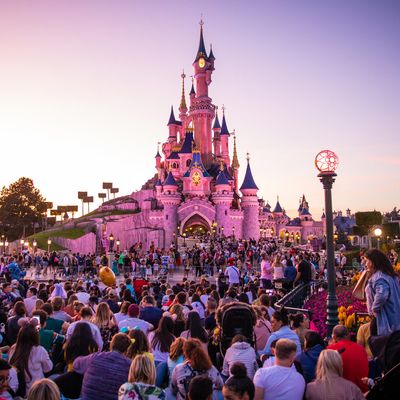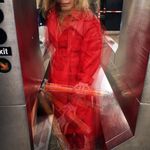
The successful launch of the Disney+ streaming service has been getting a lot of attention and boosting the Walt Disney Company’s stock price, but that’s not the only bright spot in the company’s recent performance. When Disney announced quarterly earnings two weeks ago, it said its “parks, products and experiences” segment generated 8 percent more revenue and 17 percent more operating income in this year’s third calendar quarter than in the same quarter a year earlier.
How did the company make more money at its theme parks? Mostly by raising prices. But Disney says it’s for your own good.
“At parks, our strategy of managing yield to drive greater profitability and enhance the guest experience continues to pay off,” said Walt Disney Company CFO Christine Mary McCarthy on the company’s earnings call.
Until 2016, Disney park ticket prices were the same every day, but now prices are tiered based on they day you visit into “value,” “regular,” and “peak.” The company frames this as a matter of “yield management” — using low prices to push guests to visit on off-season Tuesdays and high prices to make the parks less oppressively crowded on summer Saturdays — but in practice, Disneyland’s base ticket price on “value” days ($104) is sharply higher than the any-day ticket price just a few years ago ($87 in 2012). Plus, there were only 47 value-price days in 2019 and the last one was May 23, so for the rest of the year, if you’re over the age of 9, you won’t be getting into Disneyland for less than $129. On peak days, that will be $149.
These high prices are one factor that has suppressed crowds, at least at Disneyland in California. Back in July, the Orange County Register reported on an “apparent scarcity of visitors” that made this summer “the best time to visit Disneyland.” That seems to be holding true in the fall: I visited Disneyland on Tuesday; my one-day park ticket was a whopping $194, and, true to Disney executives’ claims, my guest experience was indeed enhanced by what appeared to be relatively limited crowds.
The base ticket price on Tuesday was $129, so how did I end up paying $194? Because I paid $50 for the privilege of visiting both Disneyland Park and Disney California Adventure on the same ticket, and another $15 for MaxPass, a feature that allowed me to make ride reservations through the Disneyland smartphone app. Tuesday was not a “peak” day; if I visited again this Saturday, the same ticket package would cost me $214.
But for this high price, I did get an experience that was a lot more seamless with a lot less waiting than I remember from Disney parks in my childhood, and not just because of relatively light crowds. The MaxPass offering meant my friends and I could take out our phones at noon, standing inside the new, Star Wars–themed Galaxy’s Edge area at Disneyland Park, and make a reservation for a 6:30 p.m. ride on Radiator Springs Racers, the Cars-themed attraction that draws the biggest crowds at California Adventure, about a half-mile away. When we got to Radiator Springs hours later, after many intervening rides and a few cocktails, we waited less than ten minutes to board, even as the standby rider line (for those without reservations) had a posted waiting time of 80 minutes.
If we hadn’t bought the add-ons, we wouldn’t have been able to get to all the rides we wanted to in a single day, and we would have spent a lot more time waiting in lines and shuffling around to obtain FastPass reservation tickets. And of course, if ticket prices had stayed lower, the lines might have been longer everywhere — as it stood, we were able to walk onto Space Mountain (recently rechristened Hyperspace Mountain) around 11 a.m. with no reservation and a less-than 20-minute wait.
Disney has not gone as far as its competitors in letting customers pay to avoid waiting. Unlike at Six Flags, which has tiered ticket pricing, where the more you pay the less you wait, Disney would not be so gauche as to use such an in-your-face system to rank guest importance. All guests at Disney parks are special, and therefore all guests are welcome to use the FastPass system to reserve a limited number of rides in advance and come back when it’s their turn without waiting in line.
But there are subtler ways Disney gives advantages to customers it values more: Paying for MaxPass makes it easier to use FastPass more effectively, because you can use a phone app instead of visiting physical reservation kiosks; on certain days, paying Disney hotel guests can enter the parks before they open to the public and stay after they close; in Florida, hotel guests can make ride reservations far in advance of their vacations; and for hundreds of dollars an hour, you even can hire a VIP guide to escort your family to the front of the line. And the main way Disney has been stratifying its guests is an invisible one: By raising ticket prices, it is keeping some potential guests out of the parks altogether.
Disney has said one reason for the light crowds is that it did too good a job telling people how busy Disneyland would be after Galaxy’s Edge opened this spring, and another is that guests have been waiting for the second ride to open at Galaxy’s Edge in January 2020. These factors also prevail at Walt Disney World in Florida, where Galaxy’s Edge opened this summer, but it won’t have all its attractions in place until December. So maybe the parks will be more crowded next year.
But the higher ticket prices can be expected to persist; they may go even higher if Disney is right that the crowds return in force once Galaxy’s Edge is complete, requiring further price increases to achieve proper “yield management” and guest satisfaction.





























